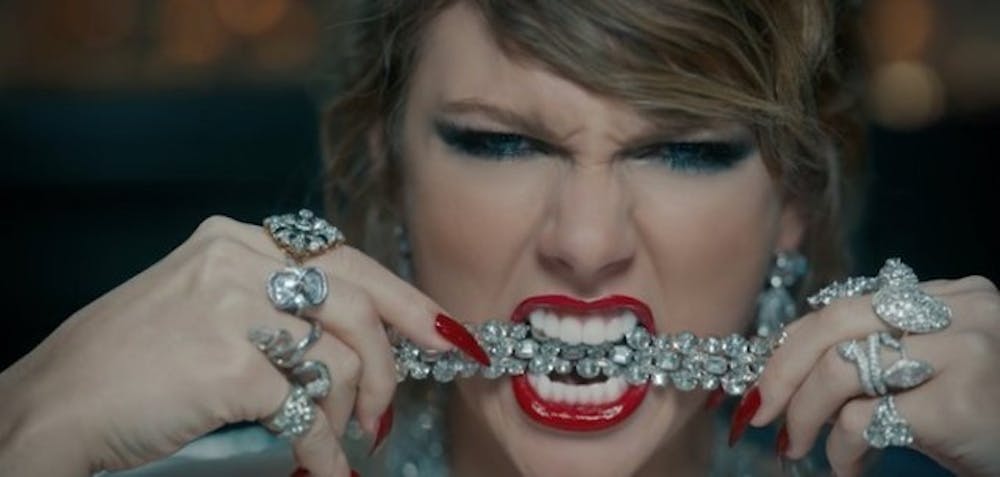After returning her songs to Spotify, a silent Taylor Swift has returned to the stage with the single “Look What You Made Me Do.” This is the first track released in anticipation of her upcoming album “reputation.” Though the new song presents Swift as tough, intense and self-aware, the actual perception this song creates does the opposite.
“Look What You Made Me Do” turns to Swift’s old feuds without naming names, pushing them back to the forefront of her brand. Where she tries to subtly reclaim her actions towards Kanye West, Kim Kardashian and all whom she has come at odds with, she still comes off as a victim. She claims that the old Taylor is dead but the same Taylor seems to be alive and well. This becomes evident in the single’s music video where each of her iterations is revived.
The video begins with an ominous scene of thunder, lightning and crows panning over a foggy graveyard, before zooming into the tombstone where “Taylor Swift’s Reputation” has been laid to rest. As the punchy bells and orchestral introduction begin, a zombie Swift crawls out of the soil, eyes ablaze and cheeks hollowed. The delicate introduction is interrupted with the stark, simple pop beat which drives the song and Swift’s tirade of grievances.
After a cut to Swift laying in a claw-footed bathtub full of diamonds and jewelry, she whispers her objections — soft and monotone — as if she is building towards a grand plan, but Swift ultimately misses the mark and comes off bitter. Lyrically, the whole song is significantly less mature and developed than that of her past work, as it is littered with clichés and ambiguous assertions such as “I don’t like your perfect crime / How you laugh when you lie.” In a verse aimed mainly at the controversy over Kanye West’s reference to Swift in “Famous,” punctuating each phrase with “I don’t like you” was a missed opportunity for any substantive assertions.
The bridge kicks off with a snappy snare drum and rapid piano while the humming bass builds underneath. Swift sits atop a golden throne with snakes slithering up black and gold shining stairs and columns around her, serving her tea and drawing the eye toward not only her snake-themed jewelry but also the “Brute” portion of the “Et tu, Brute” inscriptions on the columns and the armrests of her throne.
Through this juxtaposition, Swift calls attention to the deceiving snake label ascribed to her in the wake of the conflict with West. In an attempt to reclaim the snake label and depict her as powerful, the lyrics do the opposite. Her tone is bitter and angry — the verse, “I’ve got a list of names and yours is in red, underlined,” seems to maintain that a burn book makes someone a force to be reckoned with.
The chorus cuts in with the same incessant snare drum as Swift repeatedly slurs the song title. The video then shows Swift crashing an immaculate gold sports car with shards of glass, jewelry and debris flashing across the screen as she clutches her Grammy. It is theatrical and drawn out, emphasizing how others’ are responsible for her missteps, though speculation suggests that the Grammy is a nod toward her feud with Katy Perry, who has never won the award. The scene is ornate and glamorous and the sarcasm is palpable, but to no identifiable end before transitioning into an awkward, swirling and clumsy rap verse.
All of a sudden a new Taylor enters the scene aggressive, bold and angry. Baseball bats swing, lips sneer and hoodies are thrown on as she dips her feet back into rap culture. The scene is disconcerting given the political climate and lacks the light-hearted jubilee that made the problems in the “Shake it Off” video somewhat digestible. Perhaps the look was supposed to satirize Swift’s new unabashed, self-serving persona, but the song itself lacks the nuance to do so. If anything, the aesthetic choice confirms that Swift’s critics cannot influence her behavior — for better or for worse.
The video closes with 14 Taylor Swifts — each representing a character from her past videos and public appearances — standing in different costumes. The personas heckle and harass one another as audience cheers fade into the background. It is one of the few self-aware moments of the video, as typical online criticisms towards Swift are exchanged back and forth in an attempt at self-deprecating humor — but this all falls flat when the clones all yell, “Shut up!” after one of the Taylors requests to be “excluded from the narrative.” The sentiment could have seemed genuine, but only if the entire song had not been about reinvigorating the drama of yore.
Overall, the three-year build up to Swift’s new material was lackluster. The writing and production quality met expectations with a new tone. While Swift’s former sweetheart persona was pronounced dead, the new Taylor seems to be up to the same tricks.







